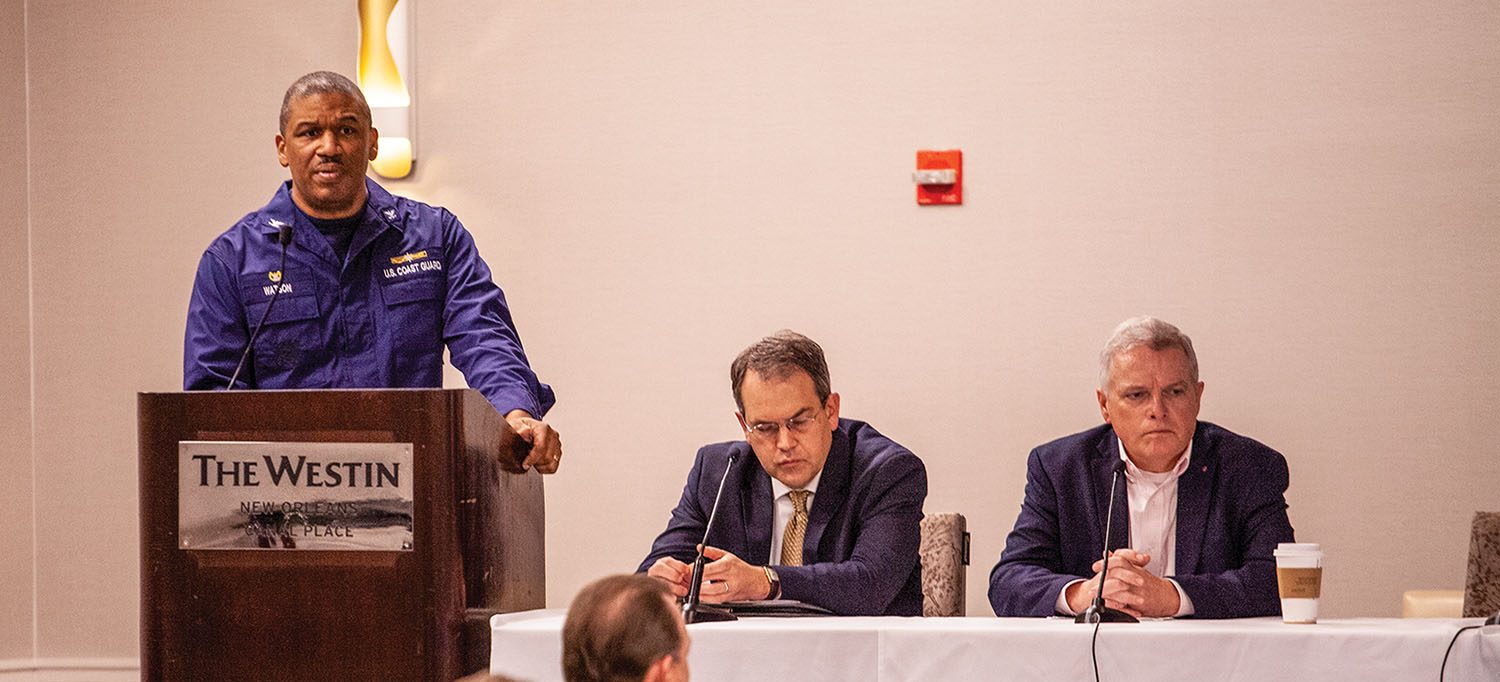After canceling its 2021 meeting due to the COVID-19 pandemic, the Mississippi Valley Trade & Transport Council (MVTTC) held its annual conference February 24, marking the group’s 40th anniversary. Held in New Orleans in the days leading up to Mardi Gras, the conference captured the celebratory spirit of the city, while also focusing on core topics of infrastructure, the economy, workforce development and commodities.
David Ryan, MVTTC chairman and vice president of sales for Associated Terminals, opened the conference with a welcome to attendees, while Louisiana Lt. Gov. Billy Nungesser delivered a keynote address. The conference then got down to business with a river operations and infrastructure panel discussion that featured Sean Duffy, executive director of the Big River Coalition, as moderator; Capt. Will Watson, captain of U.S. Coast Guard Sector New Orleans; Eddie Belk, director of programs for the U.S. Army Corps of Engineers’ Mississippi Valley Division; R. Christian Johnsen, a partner with Jones Walker LLP; and Mike Steenhoek, executive director of the Soy Transportation Coalition.
Watson pointed to Hurricane Ida, which came ashore in Southeast Louisiana August 29, 2021, and crossed over the Mississippi River near Reserve, as an example of how federal agencies, the maritime industry and local partners can cooperate and come together during a natural disaster. Watson recalled that week, in large part, being just a normal week.
“Hurricane Ida, like several other storms we’ve dealt with over the last several years, didn’t provide us with a lot of lead time,” he said. “As you’ll recall, it popped quickly and intensified rapidly.”
As the storm approached and intensified, though, emergency managers had to ramp up their operations tempo rapidly. As part of that, the Coast Guard activated the regulated navigation area (RNA) for New Orleans, which meant vessels had to move out of or away from certain flood control structures.
“The last thing you want is something bouncing around there as the storm comes through that damages the flood protect,” he said.
By August 28, 2021, it became clear that the area was going to be hit by a major hurricane, and yet the river still had ships in port that now had no time to head out to sea. Watson said one of the innovations during Hurricane Ida was the opening of some emergency anchorages, which was done in coordination with pilots, the broader maritime industry and local agencies.
Watson described how devastating it was for the storm to cross the river at such a painfully slow pace. He also discussed the river closure that followed the storm due to vessel groundings and downed transfer wires across the river. Despite those challenges, the Coast Guard, Corps and local agencies were able to reopen the river to commerce within just three days of the storm.
“Having the river closed [for an extended period] was a bad idea, so as soon as we could get it open, working with the Corps and working with you all, we got it open, then fully opened six days after,” he said.
Again, Watson highlighted the importance of teamwork, good communications and a phased-in closure of the river to allow vessels to reposition in stages.
Looking into the future, Watson said, of course, the area will continue to have to deal with hurricanes. Besides that, the region will have to contend with increased activity, cargo volumes and congestion as the demand for goods continues to grow. All that will continue to require cooperation and coordination among stakeholders on the river.
Belk, Johnson and Steenhoek all spoke on infrastructure projects and funding. That too highlighted the partnerships along the nation’s waterways, with the Soy Transportation Coalition putting forth $2 million to help get the Mississippi River Ship Channel deepening project underway and farmers setting aside $1 million to cover pre-engineering and design expenses for Lock and Dam 25.
Duffy then offered an update on the effort to deepen the Mississippi River Ship Channel to 50 feet. While the deepening continues to move forward in stages, some unknowns exist with regard to surveying and certifying the depth of some pipelines that cross the river. The solution, Duffy said, depends on mobilizing or developing the required technology.
As always, stakeholders must maintain a team mentality, Duffy said, and stay vigilant as they promote the industry.
Later in the conference, Church Arnold, chief commercial officer for Ingram Marine Group, and Bob Hodge, senior analyst for IHS Markit, took a look at the economic factors influencing barge rates and other aspects of the maritime industry. A pair of other panels looked at commodities, fuels, logistics, labor and ancillary services related to the transport of coal.
Rick Schwab, senior director of the Maritime & Industrial Training Center at Delgado Community College in New Orleans, talked about recruitment and workforce development in the maritime industry.
Jefferson Keever, government affairs representative for T. Parker Host, also addressed the group, speaking on current operations and future plans for Avondale Marine.
As in years past, MVTTC capitalized on taking place leading up to the biggest weekend for Carnival parades in New Orleans. Besides the after-conference dinner in the historic French Quarter, MVTTC hosted a parade party on St. Charles Avenue the following Saturday for the Krewe of Iris and Krewe of Tucks parades.
Caption for photo: Capt. Will Watson, captain of U.S. Coast Guard Sector New Orleans, speaks at the podium; next to him are Mike Steenhoek, executive director of the Soy Transportation Coalition and Eddie Belk, director of programs for the U.S. Army Corps of Engineers’ Mississippi Valley Division. (Photo by Frank McCormack)




